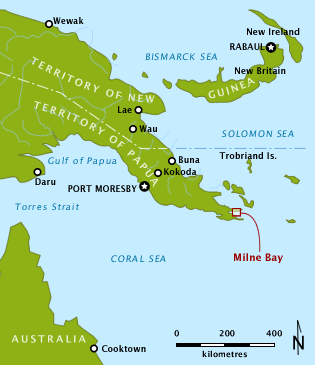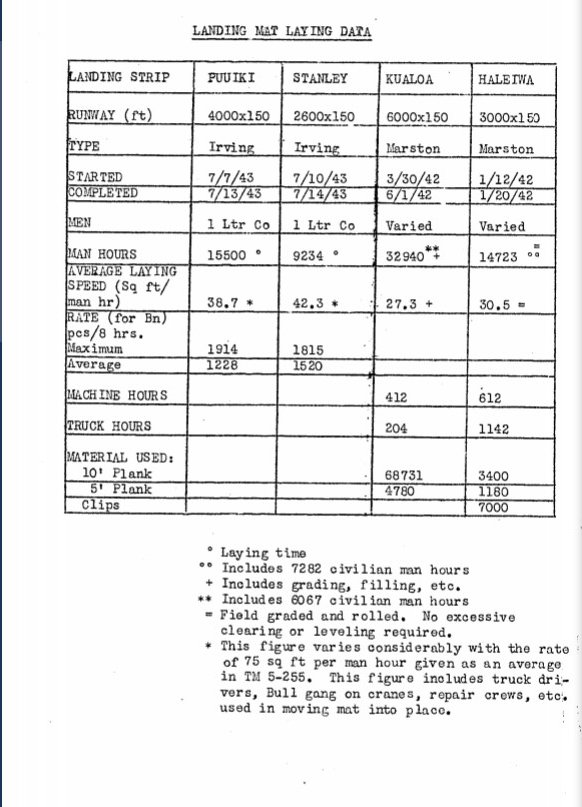
The subject of this twitter thread is US Military airfield engineering in the Pacific War and several documents I uncovered answering a RFI from the Australian War Memorial via a US Army officer I know. 1/ 

Australian War Memorial requested information on the US Army's 43rd Engineer Battalion and their participation in the Battle of Milne Bay, August through September 1942.
I was pinged by the US officer, who is in Oz right now, to help. 2/
I was pinged by the US officer, who is in Oz right now, to help. 2/

The 43rd Engineer Btn is on wikipedia--
en.wikipedia.org/wiki/43rd_Engi…
According to the wiki the 43rd "was activated at Fort Snelling, Minnesota on 10 February 1941, before being redesignated on 16 March 1943 as the 43rd Engineer General Service Regiment. 3/
en.wikipedia.org/wiki/43rd_Engi…
According to the wiki the 43rd "was activated at Fort Snelling, Minnesota on 10 February 1941, before being redesignated on 16 March 1943 as the 43rd Engineer General Service Regiment. 3/
The 1st and 2nd Btns were disbanded on 22 Apr 1944 in Australia with the remainder of the regiment reorganized & redesignated as the 43rd Engineer Construction Battalion on 9 May 1944."
This "change and reorganize" game makes finding specific unit history a cast iron b-tch. 4/
This "change and reorganize" game makes finding specific unit history a cast iron b-tch. 4/
My usual go-to source for US Army unit histories is the WWII Operational Documents Section of the Ike Skelton Combined Arms Library Digital Library. 5/
cgsc.contentdm.oclc.org/digital/collec…
cgsc.contentdm.oclc.org/digital/collec…
I struck out with every single 43rd Engineer (Insert Unit Here) combination I could think of.
This was in both in the Operational History & General History Section (See Link below). 6/
cgsc.contentdm.oclc.org/digital/collec…
This was in both in the Operational History & General History Section (See Link below). 6/
cgsc.contentdm.oclc.org/digital/collec…
Each US Army battalion or larger organization was supposed to send a unit history to GHQ SWPA upon reorganization/transformation, to be sent later to the War Department. MacArthur's General Headquarters could not be bothered with such things until late 1943. 7/
Then I had my "A-hah!" moment.
The SWPA Chief Engineer Maj. Gen. Hugh J. Casey, a native Kansan, did an eight volume history of SWPA engineer operations as part of an audition to become the head of the US Army Corps of Engineers in the Truman Administration.
He failed. 8/
The SWPA Chief Engineer Maj. Gen. Hugh J. Casey, a native Kansan, did an eight volume history of SWPA engineer operations as part of an audition to become the head of the US Army Corps of Engineers in the Truman Administration.
He failed. 8/
But the Hathitrust web site (hathitrust.org) had a copy of Engineers of the Southwest Pacific Volume Six Airfield and Base Development.
I tried to use a Google search to find Vol. 6 on the Hathitrust site. Then I found Google has gotten jealous of Hathitrust. 9/
I tried to use a Google search to find Vol. 6 on the Hathitrust site. Then I found Google has gotten jealous of Hathitrust. 9/
Google is now playing Hathitrust's game by putting old WW2 gov't documents on-line and it directed me here instead:
Engineers of the Southwest Pacific, 1941-1945: Airfield and Base Development, By Hugh John Casey, United States Army Forces, Pacific 10/
play.google.com/books/reader?i…
Engineers of the Southwest Pacific, 1941-1945: Airfield and Base Development, By Hugh John Casey, United States Army Forces, Pacific 10/
play.google.com/books/reader?i…
You can find the buildup of Milne Bay infrastructure -- to include the 43rd Engineer Battalions role there -- on pages 104 - 116 in the previous tweet's link. 11/
In all of the above I also found a series of reports airfields titled:
Report of trip to the (Name) Pacific Theater of Operations with reference to planning, dispersion, construction, landing mat, concealment, camouflage, maintenance and operations, etc 12/
Report of trip to the (Name) Pacific Theater of Operations with reference to planning, dispersion, construction, landing mat, concealment, camouflage, maintenance and operations, etc 12/
This is the first of the three:
Report on observations in the Central Pacific Theater of Operations, 25 January 1944. 13/
cgsc.contentdm.oclc.org/digital/collec…
Report on observations in the Central Pacific Theater of Operations, 25 January 1944. 13/
cgsc.contentdm.oclc.org/digital/collec…

This series of reports dated Dec. 1943 through Jan. 1944 are just filled with historical gems.
Would you believe the MacArthur's SWPA was auditioning for B-29's for use at Port Moresby in Dec 1943? 14/
Would you believe the MacArthur's SWPA was auditioning for B-29's for use at Port Moresby in Dec 1943? 14/

The compare and contrast with the South Pacific Theater can be seen here:
Report on observations in the South Pacific Theater of Operations, 15 January 1944. 16/
cgsc.contentdm.oclc.org/digital/collec…
Report on observations in the South Pacific Theater of Operations, 15 January 1944. 16/
cgsc.contentdm.oclc.org/digital/collec…

The expansion of Allied airfields on Guadalcanal by January 1944 has to be seen to be believed.
These photos are of Henderson Field, Navy Fighter strip one, plus Fighter strips one and two.
17/


These photos are of Henderson Field, Navy Fighter strip one, plus Fighter strips one and two.
17/



What stood out for me was the section on Japanese Aerial Tactics.
The Japanese Okinawa Campaign tactic of following Allied air raids into the landing pattern at night, & the 1st Japanese use of Chaff/Window in 1943, are both mentioned and described respectively in Jan 1944.
19/

The Japanese Okinawa Campaign tactic of following Allied air raids into the landing pattern at night, & the 1st Japanese use of Chaff/Window in 1943, are both mentioned and described respectively in Jan 1944.
19/


This is the final report of the series:
Report on observations in the Central Pacific Theater of Operations, 25 January 1944. 20/
cgsc.contentdm.oclc.org/digital/collec…
Report on observations in the Central Pacific Theater of Operations, 25 January 1944. 20/
cgsc.contentdm.oclc.org/digital/collec…

The difference in panicked but through airfield construction between Hawaii & adjacent islands vs. the South/SW Pacific is stark. Every kind of surface matting is used in Hawaii, even on Golf courses!
21/



21/




The amount of engineering effort into Hawaii airfield camouflage, revetments, and decoys was mind boggling.
22/

22/


Canton Island, to the Southwest of the Hawaiian Islands, got a similar treatment for aircraft & their revetments.
The SCR-270 radar was not only camouflaged with sand paint, a complete 100% fidelity decoy antenna was constructed to divert attacks.
23/



The SCR-270 radar was not only camouflaged with sand paint, a complete 100% fidelity decoy antenna was constructed to divert attacks.
23/




Looking across these WW2 documents and the current headlines with China.
I can't get over how much has been forgotten...
...and may have to be learned again
I can't get over how much has been forgotten...
...and may have to be learned again
@threadreaderapp unroll
• • •
Missing some Tweet in this thread? You can try to
force a refresh








